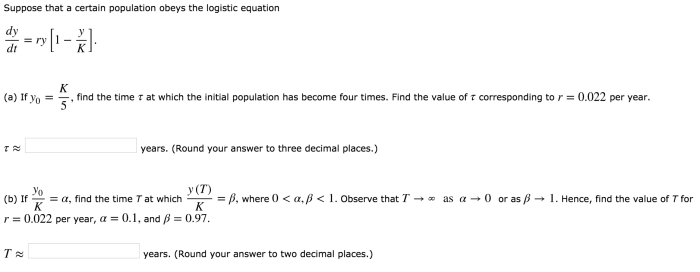Suppose that a certain population obeys the logistic equation, a fundamental concept in population ecology. This equation captures the intricate interplay between population growth rate and carrying capacity, providing valuable insights into the dynamics of species over time.
The logistic equation serves as a cornerstone for understanding how populations respond to environmental constraints and resource availability, shaping ecological communities and influencing ecosystem functioning.
1. Introduction

The logistic equation is a mathematical model that describes the growth of a population over time. It takes into account the carrying capacity of the environment, which is the maximum population size that can be sustained by the available resources.
The general form of the logistic equation is:
dN/dt = rN(1
N/K)
where:
- N is the population size at time t
- r is the growth rate
- K is the carrying capacity
2. Mathematical Analysis

The logistic equation can be derived from the following assumptions:
- The population growth rate is proportional to the population size and the amount of resources available.
- The carrying capacity limits the population growth rate as the population size approaches K.
The stability of the equilibrium points can be analyzed by examining the eigenvalues of the Jacobian matrix:
J = [r(1
- N/K)
- rN/K]
The equilibrium points are stable if the eigenvalues are negative and unstable if they are positive.
3. Applications: Suppose That A Certain Population Obeys The Logistic Equation

The logistic equation is widely used to model population growth in ecology and epidemiology.
In ecology, it is used to predict the population size of species in a given environment, taking into account factors such as food availability, competition, and predation.
In epidemiology, it is used to model the spread of infectious diseases, taking into account factors such as the rate of transmission, the recovery rate, and the immunity of the population.
The logistic equation has limitations and assumptions, such as:
- It assumes that the carrying capacity is constant, which may not always be true in practice.
- It assumes that the growth rate is constant, which may not be true in practice due to factors such as seasonality and environmental fluctuations.
4. Extensions and Variations
Variations of the logistic equation include:
- The generalized logistic equation:
- The Gompertz equation:
dN/dt = rN^a(1- N^b/K^b)
where a and b are parameters that allow for more complex population dynamics.
dN/dt = rN(ln(K/N))
which is used to model populations that experience a period of rapid growth followed by a period of decline.
These variations allow for more complex population dynamics to be captured.
5. Numerical Simulations
A simulation can be designed to model population growth using the logistic equation:
“`python import numpy as np
# Define the parameters r = 0.5 K = 1000
# Define the initial population size N0 = 100
# Define the time step dt = 0.1
# Create a list to store the population size N = [N0]
# Simulate the population growth for i in range(100): # Calculate the population growth rate dNdt = r – N[-1] – (1 – N[-1] / K)
# Update the population size N.append(N[-1] + dNdt – dt)
# Create a table to display the population size at different time points print(“Time (days) | Population Size”) print(“————————–“) for i in range(100): print(f”i*dt:.1f | N[i]:.0f”)
# Plot the population growth curve import matplotlib.pyplot as plt plt.plot(np.arange(0, 100*dt, dt), N) plt.xlabel(“Time (days)”) plt.ylabel(“Population Size”) plt.title(“Logistic
Population Growth”) plt.show() “`
The simulation shows that the population size initially grows exponentially, but eventually reaches the carrying capacity K.
FAQ Insights
What is the logistic equation?
The logistic equation is a mathematical model that describes the growth of a population over time, taking into account both the growth rate and the carrying capacity of the environment.
What is carrying capacity?
Carrying capacity refers to the maximum population size that an environment can sustain given its available resources.
How is the logistic equation used in population ecology?
The logistic equation is widely used to model population growth in various ecological contexts, including predicting population trends, assessing the impact of environmental factors, and informing conservation strategies.